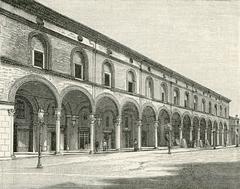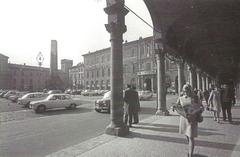Palazzo Ginnasi Visiting Hours, Tickets, and Travel Guide – Imola, Italy
Date: 14/06/2025
Introduction
Palazzo Ginnasi, a refined testament to Imola’s aristocratic and architectural heritage, stands proudly in the city’s historic center. This Renaissance-Baroque palace, with its centuries-old lineage and noble façades, is a focal point for culture, history, and community events. Whether you are passionate about architecture, enchanted by noble history, or simply exploring Emilia-Romagna’s cultural gems, this guide offers all the essential details on Palazzo Ginnasi’s visiting hours, ticketing, accessibility, and nearby attractions to help you plan an unforgettable visit.
For the most current information on visiting Palazzo Ginnasi, including special events and open days, consult the official Imola tourism portal and dedicated local resources (Imola Tourism), (Visitare Imola), and (Castelbolognese.org).
Historical Context and Architectural Evolution
The Ginnasi Legacy in Imola
The Ginnasi family, whose roots in Imola reach back to the Middle Ages, played a vital role in the city’s political, religious, and cultural life. The family’s influence extended over centuries, producing notable figures such as Cardinal Domenico Ginnasi and endowing local institutions, including schools and orphanages (Castelbolognese.org). The palace itself, at Via Appia 39, is not to be confused with the similarly named residence in Rome, but stands as a unique symbol of Imola’s noble past.
Architectural Evolution
Palazzo Ginnasi underwent significant transformations in the 18th century, likely under architect Cosimo Morelli, who unified several 16th-century buildings into a single grand residence. The palace’s external facades, visible from both Via Appia and Via Cavour, are adorned with the distinctive coats of arms of the Ginnasi and Poggiolini families — the compass and stars for the Ginnasi, and the hills and roses for the Poggiolini (ilrestodelcarlino.it).
Architectural Features and Artistic Highlights
Exterior and Courtyards
Palazzo Ginnasi’s late Baroque exterior features harmonious proportions, classical stonework, and noble blazons. The building is organized around two courtyards:
- Service Courtyard (Via Cavour 65): Once home to the stables, this area reflects the palace’s functional history.
- Main Courtyard: A grand space for guests, highlighted by a scenographic Neptune fountain, typical of 18th-century noble residences (visitareimola.it).
Interior Decoration
While the palace’s interior is only occasionally open to the public, it contains noteworthy artistic treasures. Two ground-floor rooms are decorated with eight tempera landscape paintings by Alessandro Della Nave and Antonio Villa, capturing the refined tastes of Imola’s elite in the late 1700s (visitareimola.it; visitareimola.it, English). Frescoes, stucco work, and original architectural elements make the interiors a highlight during special open days.
The Ginnasi Family: Social and Cultural Impact
Beyond architecture, the Ginnasi family’s influence is woven into Imola’s civic fabric. Their philanthropy established institutions such as the Orfanotrofio Femminile Alessandro Ginnasi, later the city’s elementary school (Castelbolognese.org). The palace has also adapted to many roles over time, serving as a tobacco factory, cinema, and social venue, demonstrating its centrality in Imola’s urban evolution (castelbolognese.org).
Visiting Palazzo Ginnasi: Practical Information
Location
- Address: Via Appia 39, Imola, Italy
- Service Courtyard: Via Cavour 65
- Central Position: Walkable from other major Imola attractions
Visiting Hours and Tickets
- Regular Access: The palace currently functions as an office and private residence, so regular public entry is not available.
- Exterior and Courtyards: Facades and courtyards can be viewed from the street at any time.
- Special Openings: During local cultural events or heritage days, parts of the palace open for guided tours. Entry is typically free or may carry a nominal fee.
- Booking and Information: For the latest on open days and tours, contact the Imola Tourist Office:
Phone: +39 0542 602207
Email: [email protected]
Accessibility
Palazzo Ginnasi is located in Imola’s pedestrian-friendly historic center. The courtyards are generally accessible; however, due to the building’s age, some areas may be challenging for visitors with mobility needs. Contact the tourist office for detailed accessibility information.
What to See
- Façades and Coats of Arms: Admire the detailed stonework and heraldic crests on Via Appia and Via Cavour.
- Courtyards: The Neptune fountain in the main courtyard is a fine example of 18th-century garden design.
- Interiors (Special Openings): View rare tempera landscapes and late Baroque decorative elements by Della Nave and Villa.
Nearby Attractions
Palazzo Ginnasi’s central location places it within easy reach of Imola’s other notable sites:
- Rocca Sforzesca: 14th-century fortress and museum with panoramic city views (Rocca Sforzesca)
- Imola Cathedral (San Cassiano): Romanesque-Gothic church with significant artworks (Imola Cathedral)
- Palazzo Tozzoni: Another noble residence, now a museum (Palazzo Tozzoni)
- Regional Museum of Ceramics: Celebrating Imola’s artisanal heritage
Motorsport fans can also visit the Autodromo Enzo e Dino Ferrari for racing events and tours.
Cultural Tips and Visitor Information
Best Time to Visit
June offers warm, sunny weather — ideal for enjoying Imola’s historic streets and outdoor sites (thetravelfolk.com). Early booking is recommended during peak season.
Local Etiquette
As Palazzo Ginnasi contains offices and residences, respect occupant privacy. Photograph only the exterior and courtyards unless otherwise permitted during special events.
Events and Special Openings
The palace occasionally opens for heritage days, concerts, or exhibitions. Check (Visitare Imola) or contact the tourist office for schedules.
Frequently Asked Questions (FAQ)
Q: What are the regular visiting hours of Palazzo Ginnasi?
A: There are no regular public hours; the exteriors and courtyards are viewable from the street at any time. Interior access is limited to special events.
Q: Is there a ticket or entrance fee?
A: No fee is required to view the exterior and courtyards. Special event tours may be free or require a nominal charge.
Q: Are guided tours available?
A: Guided tours are offered during special cultural events. Contact the Imola Tourist Office for upcoming opportunities.
Q: Is the palace accessible for visitors with mobility challenges?
A: The historic nature of the building means some areas may not be fully accessible. Contact the tourist office for assistance.
Q: How can I get updates on opening hours and events?
A: Visit the Imola Tourism website or contact the Imola Tourist Office.
Visuals and Media
For an enriched experience, look for images of Palazzo Ginnasi’s intricate façades, Neptune fountain, and the rare tempera landscapes by Della Nave and Villa. When sharing online, use alt tags such as “Palazzo Ginnasi visiting hours,” “Palazzo Ginnasi tickets,” and “Imola historical sites” to improve accessibility and searchability.
Plan Your Visit: Next Steps
- Download the Audiala mobile app for offline maps, guided tours, and event notifications.
- Follow Imola’s official tourism channels for real-time updates.
- Contact the Imola Tourist Office for the latest on Palazzo Ginnasi’s special openings and guided tours.
- Explore more: After Palazzo Ginnasi, visit Rocca Sforzesca, Imola Cathedral, and Palazzo Tozzoni for a complete cultural itinerary.
Summary and Recommendations
Palazzo Ginnasi is a distinguished jewel in Imola’s cultural crown, blending Renaissance and Baroque architecture with the rich legacy of one of the city’s most influential families. While regular interior visits are limited, the palace’s remarkable courtyards, noble façades, and occasional open days offer a fascinating glimpse into Imola’s past. Its central location makes it an ideal starting point for exploring the historic city and its many attractions.
For up-to-date information on visiting hours, tickets, and events, rely on official channels such as Imola Tourism and the Audiala app. Engaging with local culture and respecting the privacy of the palace’s current occupants ensures a rewarding and responsible visit.
Sources and Further Reading
- Imola Tourism – Palazzo Ginnasi
- Visitare Imola – Palazzo Ginnasi
- La famiglia Ginnasi di Imola – Castelbolognese.org
- Rocca Sforzesca, Imola – Atlas Obscura
- Imola Cathedral – Dreamstime
- Palazzo Tozzoni – TripAdvisor


